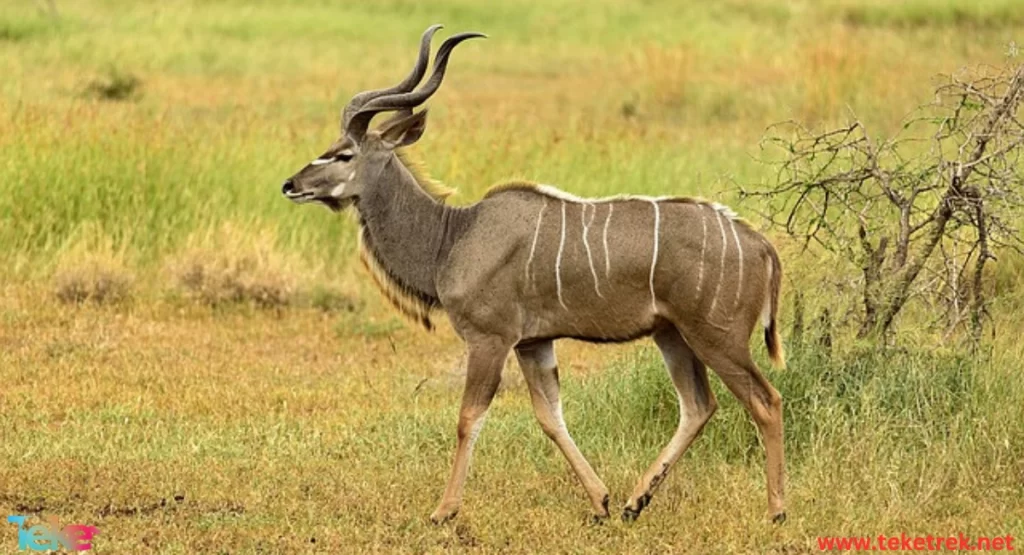is considered one of the most famous and beautiful antelopes in the world, known for its striped horizontal head, beautiful shape, and impressive horns.
Let’s learn more about it from teketrek.

Facts about The Greater Kudu
Male Kudus use their long horns to assert dominance over other males and defend themselves.
The Greater Kudu is active throughout the day. Herds of Greater Kudu disperse during the winter and rainy seasons.
Greater Kudus live in groups, with females typically forming groups of around 6 individuals, but sometimes groups can reach up to 20 individuals.
The Greater Kudu is known for its excessive activity and high alertness, making it difficult to handle.
When feeling threatened, Greater Kudus use their large radar-like ears to emit a loud bark and flee quickly with distinctive and exciting movements.
Greater Kudus’ horns twist once around the age of two years and start appearing between 6 to 12 months.
Despite their large size, Greater Kudus can jump approximately 2 meters.
Greater Kudus are not considered domestic animals as they can be aggressive and attack.
They walk in large herds composed of around 40 individuals due to their dietary habits.
The natural habitat of the Greater Kudu is Africa’s savannas, forests, and plateaus.
Due to living in herds, finding food can be challenging in large groups.
Their range can cover approximately 800 to 1500 acres (3.2 to 6.1 square kilometers), with the herd spending around 54% of the day foraging for food.
During the dry season, few areas concentrate nutrients attracting the herds.
The Greater Kudu specification
The body: The Greater Kudu has a beautiful body with spots and white stripes on the upper and lower parts of the neck.
Hair:Many Greater Kudus have white hair between their eyes.
Horns: Male Greater Kudus have long, spiral horns that can reach lengths of approximately 1.8 meters, making them agile and fast.
Their horns curve slightly upwards and backwards in a spiral shape.
Kudu size: Females are smaller in size than males.
Kudu weight: with males weighing around 230 pounds and females weighing about 150 kg.
The length: Males’ length about 1.30 and females range in length from 1 meters to 2.5 meters.
Color: The Greater Kudu is characterized by a bluish-gray, grayish-brown, or brown color.
Age: Greater Kudus usually live between 7 to 8 years, with some individuals living up to 23 years.
Where can the kudu antelope be found?
The kudu antelope can be found in African countries such as Kenya, Ethiopia, and Namibia.
It is also found in Chad, Congo, and Djibouti.
Kudus completely avoid open spaces that do not contain trees.
Kudu antelopes were introduced in small numbers to New Mexico but have not been released into the wild. Their habitat includes mixed forest environments.
What is the diet of the kudu antelope?
The diet of the kudu antelope consists of leaves, grasses, and shoots. Sometimes they feed on roots, fruits, especially oranges.
Kudus also feed on small insects and some tree bark.
Reproduction in kudu antelopes
The gestation period for kudu antelopes starts in March and lasts for about 6 months.
After this period, the female usually gives birth to a single calf.
The young kudu antelope reaches sexual maturity at one to three years old.
Before mating season, some courtship behaviors occur, including the male standing in front of the female and engaging in neck wrestling.
Although this type of animal is rarely aggressive, they can become aggressive during mating season.
They may push each other with their horns, which can sometimes result in death if the horns become entangled.

FAQs about kudu
What is the difference between Cape kudu and greater kudu?
East Cape Kudu is different from Greater Kudu, which is found in northern South Africa.The East Cape kudu is smaller in both body size and horn length compared to the greater kudu. Additionally, East Cape kudu typically have much darker skin than their greater kudu counterparts.
Why is it called a kudu?
The kudu (known as “koedoe” in Afrikaans) got its name directly from the Khoikhoi language. According to folklore, the name is thought to describe the sound made by the animal’s hooves as it swiftly escapes from predators or danger.
Is greater kudu extinct?
Status. The greater kudu population in the northern part of its range has declined due to excessive hunting and rapid habitat loss.However, they are classified as low risk on the IUCN Red List of endangered species.
Is a kudu aggressive?
No, it is rarely aggressive.
In conclusion, kudu is important to highlight the role of the kudu antelope in maintaining ecological balance. It is also worth noting the decline in their numbers in the northern part of their range due to overhunting and habitat loss. Many kudus can be found in protected areas.
References:




